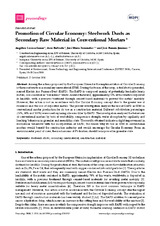Promotion of Circular Economy: Steelwork Dusts as Secondary Raw Material in Conventional Mortars
Autor
Lozano Lunar, Angélica
Barbudo Muñoz, M. Auxiliadora
Fernández, J.M.
Jiménez, José Ramón
Editor
MDPIFecha
2018Materia
Steelwork dustsSecondary raw material
Construction material
METS:
Mostrar el registro METSPREMIS:
Mostrar el registro PREMISMetadatos
Mostrar el registro completo del ítemResumen
Among the actions proposed by the European Union for the implementation of Circular Economy
is the use of waste as a secondary raw material (SRM). During the fusion of the scrap, a steel dust is generated,
named Electric Arc Furnace Dust (EAFD). The EAFD is composed mainly of potentially leachable heavy
metals, so is classified as “hazardous” waste. Around the world, approximately 70% of this waste is deposited
in landfills, with a previous treatment through cement-based materials to prevent the metals’ mobility.
However, this action is not in accordance with the Circular Economy concept due to the greater use of
resources and the loss of deposited metals. The present investigation analyses the use of EAFD as SRM in
conventional mortar production for its use as a construction material. Different substitution percentages
(25%, 50% and 100%) were used replacing siliceous filler by EAFD. The investigation analysed the behaviour
of conventional mortars by tests of workability, compressive strength, water absorption by capillarity and
leaching behaviour in granular and monolithic state. The results obtained indicate a slight improvement in
mechanical behaviour with the incorporation of EAFD, the reason why its use as SRM in conventional
mortars would benefit the construction industry and would encourage the Circular Economy. From an
environmental point of view, the mechanisms of Pb fixation should be improved in granular state.

